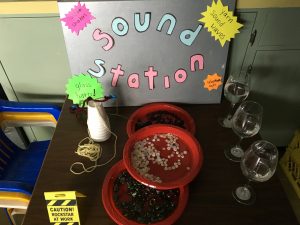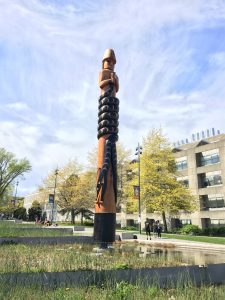Sound and Light
My favourite unit during my 10-week practicum was on Sound and Light. This unit gave me a platform to teach Aboriginal content and make my lessons experiential and place based. My SA gave me a lot of creative freedom to explore inquiry and incorporate indigeneity into my lessons.
INQUIRY
In a young learner’s classroom, inquiry plays out a little bit differently. At first I felt a bit stifled by the necessity of guiding “inquiry”, but I soon realized that I was giving my students the tools to question and learn about things that they were passionate about.
My sound and light unit was set off to motion by one great big question: is sound and light a form of energy? Division 3 had learned about energy before in our force and motions unit, and going over the terminology and the concept was a lot easier because I had background knowledge that I could work with and use as examples. We thought about what kind of materials were affected by sound and light, and we brainstormed ideas to prove (or disprove) that sound and light were in fact, forms of energy.
There were several curricular competencies that I was able to focus on with this unit. In particular, we worked on prediction and observation. Learning these two fundamental scientific skills set a tone of endless discovery.
After my first lesson on sound and its ability to set things into motion, I set up a sound station. At the sound station I had some scientific experiments that the students could conduct on their own. The only rules at the station was that they had to wear their lab coats and think of ways the particular materials created sound the way it did.
As for light, the students wanted to find out if sunlight was a source of energy. We brainstormed how we could conduct an experiment to show us that light makes things grow. We concluded that we would plant two seeds in separate pots, and put one in the sunlight and the other in a cabinet. We were so surprised by the outcome, and we couldn’t explain why! We had a gardening expert help us figure out the mystery as to why the plant grown in the dark was growing so quickly!
At the end of the unit I set up stations. They were repetitions of all of the experiments that we conducted before (but adapted and improved to go deeper into the mystery!). For their final project, I set the kids in groups of colours (of the rainbow) and had them film their own experiments and findings. This was feasible because we had done similar experiments before. Although I never gave them any “answers”, they knew what characteristics to look for because I had set up with the necessary thinking tools. After I edited the videos, we watched them together as a class, and it was evident how much they learned from it. Their curiosity and wonder was clearly demonstrated through their excitement and their desire to film all of their observations.
Another reason I gave them the task of recording their experiments as their “hand-in” assignment is that the students were able to pick a focus. They were allowed to choose what they filmed and what they wanted to learn more about; they weren’t forced to write but they were able to orate or demonstrate what they knew through film. Moreover, the students were accountable for their own learning!
The links below show two sample videos that are unedited and uncut. (The files were too large to host on WordPress)
https://www.dropbox.com/s/u5vmbl5zaemzgj8/IMG_0033.MOV?dl=0
https://www.dropbox.com/s/61jdxc3g6yl8d9u/IMG_0034%20%286%29.MOV?dl=0
INDIGENEITY
One of my greatest priorities throughout my practicum was incorporating indigeneity. It was important to me to fulfill my goals of social responsibility. I aimed to have my students understand the history of the Aboriginal peoples and their continuing presence in our communities. Indigeneity was something that I incorporated into my everyday teaching, whether it was relaying a story through a book, or visiting the post at UBC during our field trip, learning about a root or an herb during our environment unit, looking maps, or understanding the differences and similarities between the systems of currency exchange (coin value unit!).
My favourite part of Aboriginal education was that I could relate it to any subject that I was teaching. Aboriginal education is more than just about the “history”; in fact, it’s more about learning about the Aboriginal peoples’ ongoing connection to the land around them. It’s about emphasizing the fact that their culture is very much alive today and so are the people who continue to live on the very land that we’ve comfortably taken from them.
One way I incorporated indigeneity was through light and sound. A topic in the curriculum was about the moon and the sun as natural sources of light. One week we talked about the moon and the Sun. We proceeded to come up with hypothesis of how the earth received light from these two celestial bodies, and the students demonstrated their versions of the revolutions with Styrofoam moons and earths. Throughout the week we read stories of the raven and his light stealing antics, but each story had a different origin. I put up a large language map of the Indigenous groups in BC, and read them stories from the Tlingit community as well as the Haida Gwaii community.
I then asked the students to ask their parents about stories regarding the moon that they may know. A few days later I shared a story from my childhood about the rabbit who lived on the moon. Then we reflected on the similarities and differences of these stories throughout different cultures. The students were able to reflect on the characteristics of these stories, and they expressed knowledge beyond my expectations. They were able to glean details from the narratives and comprehend it on a deeper level as a result of all of the scaffolding done prior to the lesson. Their ability to create connections and appreciate them was the intended goal, and through it I was able to accomplish an interdisciplinary lesson on light (and sound).
—————————————————————
CORE COMPETENCIES
The core competencies of focus throughout this unit were: Communication, Creative and Critical Thinking, as well as a Positive Personal & Cultural Identity.
- Communication was a focus through the oral tradition of Indigenous story telling.
- Creative and Critical Thinking was necessary for all of the inquiry aspects of this unit.
- The stories from the Aboriginal communities and the connections we made to our own enhances a positive personal and cultural identity.



